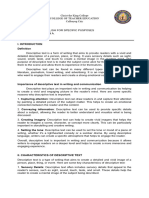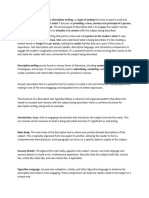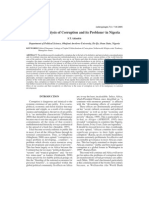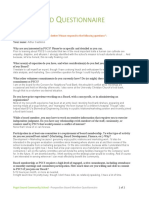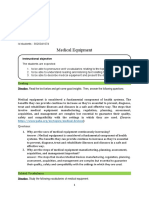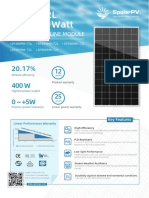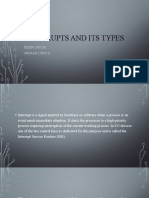Daris English Centre
Name: Date:
Features of a Descrip ve Composi on
Mahamud Sir
A descrip ve composi on focuses on pain ng a vivid picture in the reader's mind using sensory details and rich
language. The goal is to describe a person, place, object, or event in a way that allows the reader to imagine it fully.
Here are the key features and style elements of a descrip ve composi on:
1. Sensory Details
Use of the Five Senses: Effec ve descrip ve wri ng appeals to the senses (sight, sound, smell, taste, and
touch). The more specific the details, the more vivid the descrip on becomes.
o Sight: "The sunset draped the sky in brilliant shades of orange and pink."
o Sound: "The crackling of leaves underfoot echoed in the quiet forest."
o Smell: "The aroma of freshly brewed coffee filled the air, warm and invi ng."
o Taste: "The sweetness of the ripe mango danced on my tongue, its juices dripping down my chin."
o Touch: "The cool breeze brushed against my skin, sending a slight shiver down my spine."
2. Vivid Imagery
Imagery: Descrip ve composi ons rely heavily on imagery to create pictures in the reader's mind. This o en
involves the use of figura ve language such as metaphors, similes, and personifica on.
o Simile: "The lake was as smooth as glass, reflec ng the clear blue sky above."
o Metaphor: "The storm was a raging beast, tearing through the town with ferocious strength."
o Personifica on: "The trees danced in the wind, their leaves whispering secrets to one another."
3. Show, Don’t Tell
Descrip ve wri ng shows the reader what is happening instead of simply telling them. Instead of saying "She
was angry," show it: "Her face flushed crimson, and her fists clenched ghtly by her sides."
o Example: Instead of "The beach was beau ful," you might write, "Golden sands stretched endlessly
under the sun’s warm glow, while waves lazily kissed the shore."
4. Focus on Specific Details
Descrip ve wri ng o en zooms in on small, specific details to bring the subject to life. Instead of
generaliza ons, focus on minute elements that give a complete picture.
o Example: Instead of "The house was old," write, "The wooden shu ers hung crookedly on rusted
hinges, and ivy crept up the crumbling stone walls."
5. Mood and Atmosphere
Crea ng Mood: Descrip ve composi ons o en evoke a specific mood or atmosphere (e.g., peaceful, eerie,
joyful, melancholic) that enhances the emo onal impact of the wri ng.
o Example (Eerie): "The fog curled thickly around the ancient gravestones, muffling every sound and
cas ng eerie shadows in the moonlight."
o Example (Joyful): "The garden burst into a riot of colors, bu erflies fli ng joyfully among the
blooming flowers under the bright summer sun."
�6. Use of Adjec ves and Adverbs
Rich Descrip ons: Adjec ves and adverbs are essen al for adding depth to the descrip on. However, they
should be used purposefully and not overdone.
o Example: "The so , delicate petals of the rose glistened with ny droplets of morning dew."
o Cau on: Avoid overloading sentences with unnecessary adjec ves and adverbs, which can make
wri ng feel clunky.
7. Subjec ve and Objec ve Descrip on
Objec ve Descrip on: Focuses on factual, neutral descrip ons without adding personal emo ons or
opinions. Used in describing things like objects or places in a neutral tone.
o Example: "The room was 12 feet by 15 feet, with two large windows on the west wall."
Subjec ve Descrip on: Includes personal impressions, emo ons, and opinions, o en used to describe
experiences or feelings.
o Example: "The room felt suffoca ngly small, the walls closing in on me like a cage."
8. Use of Figura ve Language
Metaphor and Simile: Comparisons that create vivid images.
o Example (Simile): "The sky was as dark as ink, punctuated by the bright pinpricks of stars."
o Example (Metaphor): "The city was a living, breathing organism, with streets that pulsed with life."
Personifica on: Giving human traits to non-human things to create emo onal connec on.
o Example: "The old car groaned as it struggled up the steep hill."
9. Organized Structure
Logical Flow: Even though descrip ve wri ng is crea ve, it should have a logical flow or structure. This could
follow spa al order (from top to bo om or le to right) or be arranged by importance (most to least
significant details).
o Example: In describing a scene, you might start with the broader environment and then zoom in on
specific details, or vice versa.
10. Emo onal Appeal
Conveying Emo ons: A descrip ve composi on o en evokes an emo onal response from the reader,
connec ng them to the subject on a deeper level.
o Example: "The abandoned house, with its sha ered windows and creaking doors, seemed to mourn
its lost inhabitants."
11. First-Person or Third-Person Point of View
First-Person (Subjec ve): Used when the writer is describing something based on personal experience or
memory, o en giving an in mate or emo onal touch.
o Example: "I felt the cool breeze on my face as I walked through the orchard, the scent of apples
surrounding me."
Third-Person (Objec ve or Subjec ve): More detached, used for broader descrip ons of scenes, places, or
people without personal involvement.
o Example: "The child ran through the field, her laughter ringing out as she chased a er the
bu erflies."
�Example of a Descrip ve Paragraph:
"The sun dipped below the horizon, cas ng long, golden shadows across the sleepy village. The scent of freshly baked
bread wa ed through the cobblestone streets, mingling with the earthy aroma of damp leaves. Children’s laughter
echoed faintly in the distance as a cool breeze s rred the branches of ancient oak trees. The wooden shu ers on the
houses creaked gently, and the warm glow of lanterns flickered to life, illumina ng the stone walls with a so , amber
hue. Everything felt peaceful, as though me itself had slowed to embrace the s llness of the evening."
Summary of Features:
Sensory Details: Appeal to all five senses.
Vivid Imagery: Use metaphors, similes, and personifica on.
Show, Don’t Tell: Paint a picture through descrip on, not just statements.
Focus on Specifics: Zoom in on small details for a full, rich image.
Mood and Atmosphere: Set an emo onal tone or environment.
Adjec ves and Adverbs: Enhance the descrip on without overloading it.
Organized Structure: Maintain logical flow or spa al order.
Emo onal Appeal: Convey feelings and mood.
Figura ve Language: Use crea ve comparisons to enhance the imagery.
By employing these features and styles, a descrip ve composi on becomes more engaging and allows the reader to
vividly imagine the subject being described.




























